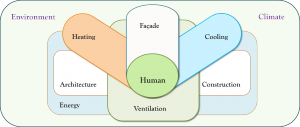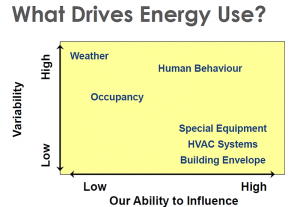In general, humans play two roles in the built environment: 1) passive receivers, and 2) active enablers.
- Humans as passive receivers of the built environment. Aside from being a shelter from the elements, buildings provide safe and comfortable environments, that should also be enjoyable and pleasant to be in. Overall buildings affect the well-being of occupants, and can even help improve or contribute to the healing process of patients (Huisman et al. 2012).
- Humans as active enablers of the built environment. Many old buildings treat occupants as passive receivers of the built environment. By contrast in residential buildings, and newer high-performance buildings humans are active enablers of the built environment “Comfort is behavior… occupants create temperature… not always, but at least at home we do…” (Nicol 2017). In either case, numerous studies have confirmed that occupant behavior is a key driver of uncertainty that impacts building energy performance and the building environment. Characterizing human behaviors in dynamic building modeling and implementing it in building designs and performance simulation tools has become a very active area of research nowadays.

Occupants’ Feedback is critical:
- How do you know what’s working?
- Employees spend less than 10 minutes a year giving feedback
- Current methods of gathering information, such as physical sensors, tend to focus on whether something is being used, not why or how it is being used
- Gather feedback directly from people as occupants interact with their space
- Once you have gathered meaningful feedback and robust data, it needs to be converted into action
- For many corporate real estate teams, the biggest challenge is making sense of all the data.
- Smart building solutions that integrate data from people and buildings are powerful
- Continuous feedback: creating the ideal workplace experience requires active management and constant iteration
(source: Comfy – Building a People-Centered Workplace: A Winning Approach to Putting your Employees First, 2017)
(source: Commissioning & Maintenance: 2 sides of the same coin?, Heinemeier K. 2017 )
Understanding human behaviors in response to the environment in buildings is complex: emotions and feelings drive our decision and actions…

Ideally, what would we wish to know about occupants in real-time, in order to deliver just the environmental conditions they need, not more, not less?
- Presence
- Location
- Count
- Activity
- Identify
- Track
- Feedback: sensation, satisfaction, preference, etc.
- Interactions with building: open/close window, open/close blinds, turn on/off fan, etc.
References
- Huisman et al. (2012). Healing environment: A review of the impact of physical environmental factors on users, Journal of Building and Environment, Elsevier, Vol. 58, pp. 70-80.
- Nicol F. (2017). Symposium: Perception of thermal comfort and pain – are we assessing their dynamics right? Heidelberg, Germany, Nov. 9-10.
